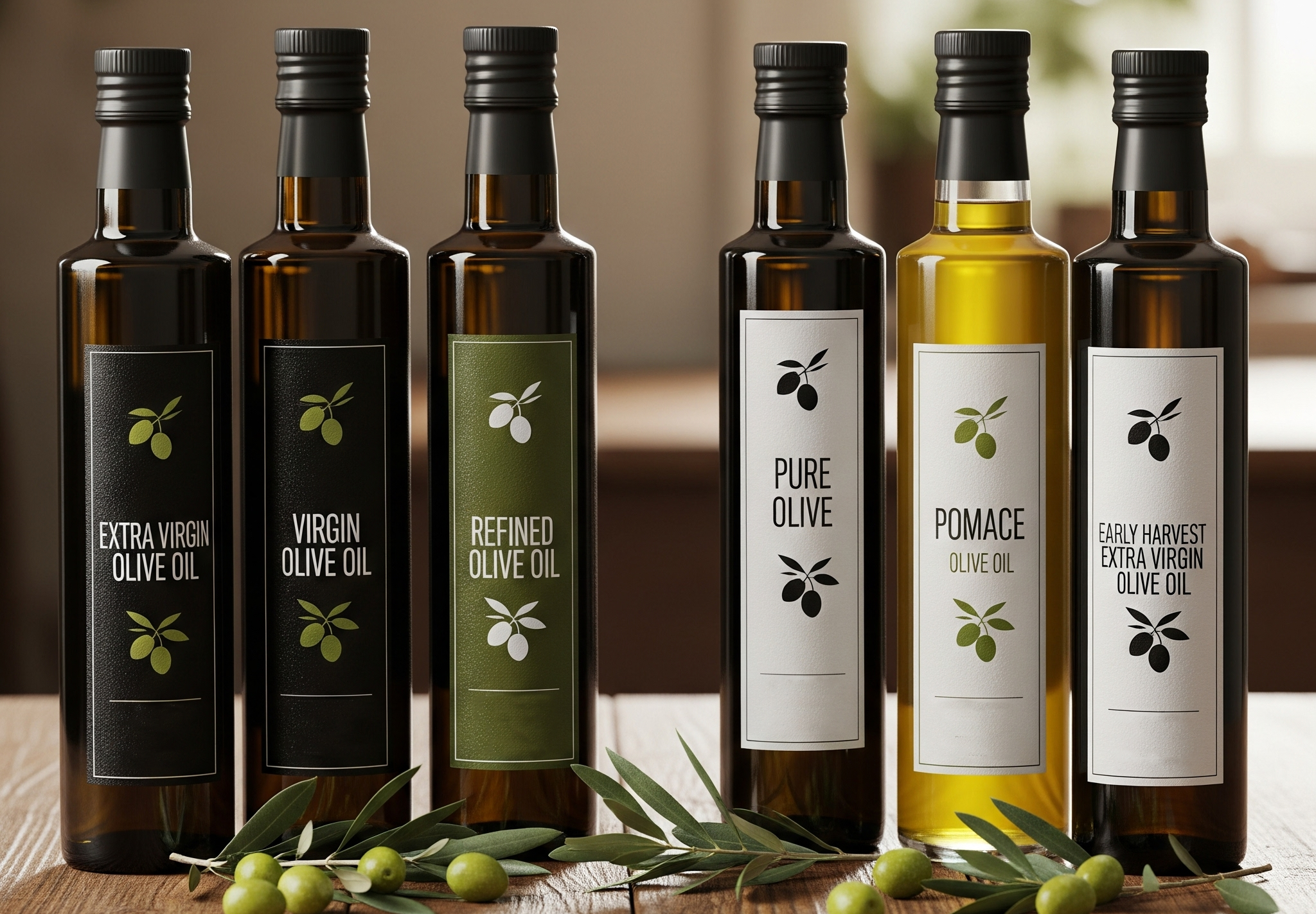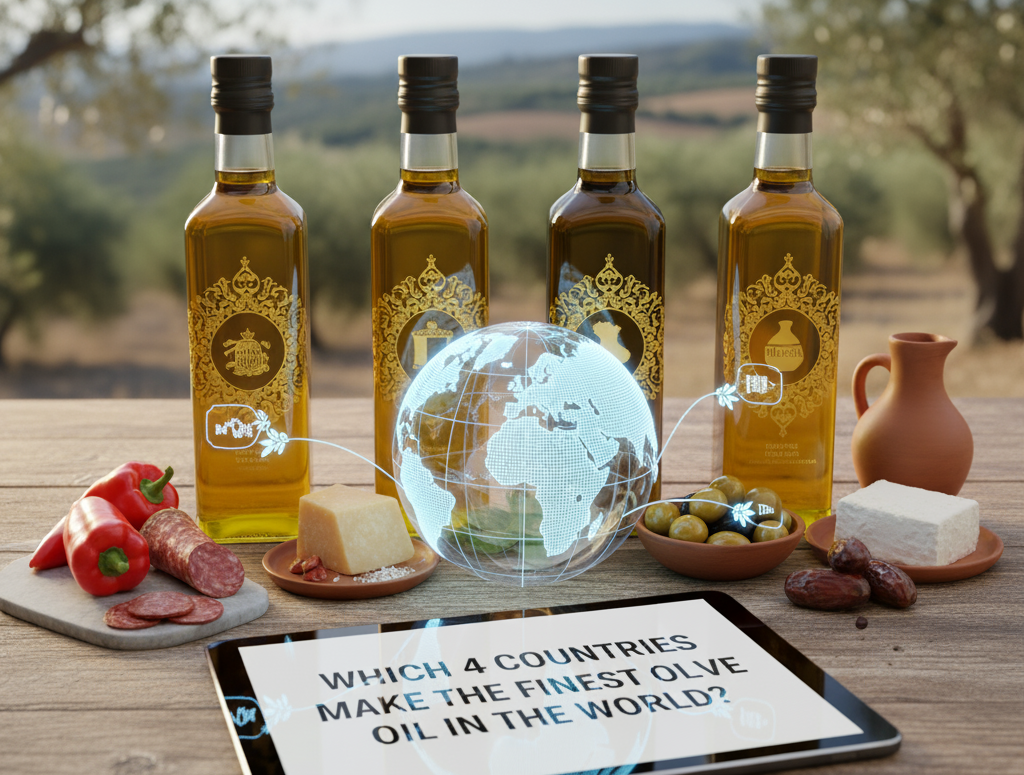
Olive Oil Classification: From Extra Virgin to Pomace – What Every Chef and Food Business Should Know
Understanding olive oil classifications can transform your culinary experience and business success. Whether you’re a home cook seeking the perfect finishing oil or a restaurant owner managing costs, knowing these six distinct classes helps you make informed decisions that impact flavour, health benefits, and cooking performance.
The olive oil market offers remarkable diversity, with each class serving specific purposes in kitchens worldwide. From the robust complexity of extra virgin varieties to the neutral versatility of refined options, mastering these classifications ensures you select the ideal oil for every application.
What Determines Olive Oil Classification?
The International Olive Council (IOC) sets global standards for olive oil classification based on three key factors: production methods, chemical composition, and sensory characteristics. These criteria ensure consistency across international markets and help consumers navigate the often confusing array of bottles on shop shelves.
Acidity levels, measured as free fatty acid percentage, serve as the primary chemical indicator of quality. Lower acidity generally indicates fresher olives and better processing methods. Production techniques—particularly temperature control during extraction—significantly impact the final classification and nutritional content.
Extra Virgin Olive Oil: The Gold Standard
Extra virgin olive oil represents the pinnacle of olive oil quality, commanding premium prices for good reason. This grade must meet stringent requirements that separate it from all other classifications.
Production Requirements:
- First cold pressing exclusively
- Maximum temperature of 27°C during extraction
- No chemical treatment or refining
- Mechanical extraction only
Quality Standards:
- Maximum 0.8% free fatty acid content
- Zero sensory defects detected by trained panels
- Superior antioxidant and polyphenol levels
- Distinct fruitiness with no rancidity
Flavour Profiles:
Extra virgin olive oil showcases remarkable diversity in taste. Delicate varieties offer buttery, subtle notes perfect for drizzling over fish or vegetables. Medium-intensity oils balance fruitiness with slight pepperiness, ideal for salad dressings. Robust versions deliver intense, peppery flavours that complement grilled meats and hearty dishes.
Best Uses:
- Finishing dishes to preserve delicate flavours
- Salad dressings and marinades
- Low-temperature cooking
- Bread dipping and drizzling
Business Applications:
Restaurants use extra virgin olive oil to differentiate their offerings and justify premium pricing. The complex flavours enhance dish presentation and create memorable dining experiences that encourage customer loyalty.
Virgin Olive Oil: Quality with Flexibility
Virgin olive oil maintains excellent quality standards whilst offering slightly more flexibility in production and pricing. This classification provides an attractive middle ground for consumers seeking quality without premium costs.
Production Standards:
- Cold pressing without chemical treatment
- Mechanical extraction methods only
- Slightly relaxed temperature controls
- First or second pressing acceptable
Quality Criteria:
- Maximum 2% free fatty acid content
- Minor sensory defects acceptable
- Good antioxidant retention
- Pleasant taste and aroma required
Characteristics:
Virgin olive oil delivers authentic olive flavours with potential minor imperfections that don’t significantly impact taste. The slightly higher acidity levels remain well within healthy ranges whilst providing cost advantages over extra virgin grades.
Practical Applications:
- General cooking and sautéing
- Baking where olive flavour is desired
- Food preparation in commercial kitchens
- Home cooking for everyday meals
Commercial Benefits:
Food manufacturers often choose virgin olive oil for products requiring olive character without extra virgin pricing. This grade offers consistent quality for large-scale production whilst maintaining authentic flavour profiles.
Refined Olive Oil: Neutral Versatility
Refined olive oil undergoes chemical or thermal processing to remove defects and create a neutral-tasting product. Whilst this processing reduces nutritional content, it produces an oil with specific commercial advantages.
Processing Methods:
- Chemical refining removes impurities and defects
- Deodorisation eliminates strong flavours
- Bleaching creates consistent colour
- Filtration ensures clarity and stability
Quality Specifications:
- Maximum 0.3% free fatty acid content after processing
- Neutral taste and aroma
- Light colour and clear appearance
- Higher smoke point for cooking
Characteristics:
The refining process creates an oil with minimal olive character, making it suitable for applications where neutral flavour is preferred. Despite reduced nutritional content compared to virgin grades, refined olive oil still contains beneficial monounsaturated fats.
Optimal Uses:
- High-heat cooking and frying
- Baking where olive flavour would interfere
- Food manufacturing requiring neutral oils
- Asian cuisines where olive character isn’t desired
Industrial Applications:
Food processors value refined olive oil’s consistency and neutral profile for mass-produced items. The higher smoke point makes it suitable for commercial frying operations and large-scale cooking applications.
Pure Olive Oil: The Strategic Blend
Pure olive oil, often labelled simply as “olive oil,” combines refined and virgin oils to balance cooking functionality with olive character. This strategic blending creates a versatile product that serves multiple culinary purposes.
Composition:
- Typically 85-90% refined olive oil
- 10-15% virgin olive oil for flavour
- Carefully controlled blending ratios
- Consistent taste profiles across batches
Quality Standards:
- Maximum 1% free fatty acid content
- Balanced flavour profile
- Good cooking performance
- Stable shelf life
Performance Characteristics:
Pure olive oil offers higher smoke points than virgin grades whilst maintaining subtle olive character. This combination makes it suitable for various cooking methods without overpowering delicate flavours.
Versatile Applications:
- All-purpose cooking oil
- Restaurant kitchens requiring flexibility
- Home cooks wanting single-oil solutions
- Mediterranean-style cooking
Economic Advantages:
Restaurants appreciate pure olive oil’s cost-effectiveness for high-volume cooking whilst maintaining olive authenticity. The balanced flavour profile works across diverse menu items without conflicting with other ingredients.
Pomace Olive Oil: Maximum Extraction Value
Pomace olive oil utilises the pulp, pits, and skin remaining after initial oil extraction. Chemical solvents extract remaining oil, creating an economical product with specific industrial applications.
Extraction Process:
- Chemical solvents extract oil from olive pomace
- Refining removes solvent residues
- Blending with virgin oil improves quality
- Strict safety standards govern production
Classifications:
- Crude pomace oil (industrial use only)
- Refined pomace oil (food-grade after processing)
- Pomace olive oil (refined pomace blended with virgin oil)
Quality Characteristics:
- Maximum 1% free fatty acid content (refined pomace)
- Neutral flavour profile
- Light colour and minimal aroma
- High smoke point suitable for frying
Commercial Applications:
- Large-scale food production
- Industrial frying operations
- Cost-conscious commercial kitchens
- Food manufacturing requiring economical oils
Market Position:
Pomace olive oil serves markets requiring olive oil authenticity at minimal cost. Food service operations use it for high-volume frying where flavour isn’t critical but olive oil labelling provides marketing benefits.
Early Harvest Extra Virgin Olive Oil: Premium Excellence
Early harvest extra virgin olive oil represents the absolute pinnacle of olive oil quality, produced from olives picked before full ripeness. This timing creates unique characteristics that command premium prices from discerning consumers.
Harvest Timing:
- Olives picked in early autumn
- Fruit harvested before full maturation
- Lower yields but higher quality
- Limited production windows
Unique Characteristics:
- Intense, complex flavour profiles
- Higher polyphenol content
- Superior antioxidant levels
- Vibrant green colour from chlorophyll
Flavour Intensity:
Early harvest oils deliver robust, sometimes aggressive flavours with pronounced pepperiness and bitterness. These characteristics indicate high antioxidant content and superior health benefits.
Premium Applications:
- Gourmet finishing oil
- Special occasion cooking
- Gift market positioning
- High-end restaurant applications
Health Benefits:
The elevated polyphenol content provides enhanced anti-inflammatory properties and antioxidant protection. Research suggests early harvest oils offer superior cardiovascular and cognitive health benefits.
Market Premium:
Producers can command significant price premiums for early harvest oils, particularly when marketing emphasises limited production and superior health benefits. Restaurants use these oils to justify premium menu pricing.
Choosing the Right Olive Oil Class
For Home Cooks
Daily Cooking: Pure olive oil provides versatility and value for everyday meal preparation.
Special Occasions: Extra virgin or early harvest oils elevate dishes and create memorable dining experiences.
High-Heat Cooking: Refined or pomace oils handle frying without breaking down or producing harmful compounds.
For Restaurants
Menu Differentiation: Early harvest and premium extra virgin oils justify higher menu prices and enhance brand positioning.
Cost Management: Virgin and pure oils balance quality with operational budgets for high-volume cooking.
Versatility: Maintaining multiple grades allows optimal oil selection for specific cooking methods and dishes.
For Food Manufacturers
Product Quality: Virgin grades maintain authentic olive character in packaged foods.
Cost Control: Refined and pomace oils provide economical solutions for large-scale production.
Label Appeal: Using “olive oil” terminology, even with lower grades, enhances product marketing appeal.
Storage and Quality Preservation
Proper storage maintains oil quality regardless of classification. Dark bottles or containers prevent light degradation, whilst cool, stable temperatures preserve flavour compounds. Minimising air exposure prevents oxidation that leads to rancidity.
Different grades offer varying shelf lives, with extra virgin oils typically lasting 18-24 months when properly stored. Refined oils may maintain quality longer due to processing stability, making them suitable for long-term inventory management.
The Future of Olive Oil Classification
Emerging trends focus on single varietal oils that highlight specific olive cultivars, harvest timing variations that create distinct flavour profiles, and sustainability integration that considers environmental impact alongside traditional quality measures.
Modern consumers increasingly value transparency, driving demand for detailed origin information, processing method disclosure, and ethical production practices. These trends influence classification systems and marketing approaches across the industry.
Making Informed Decisions
Understanding olive oil classifications empowers both consumers and businesses to make strategic choices that enhance culinary outcomes whilst managing costs effectively. Each grade serves specific purposes, and selecting appropriately ensures optimal results for every application.
The investment in proper olive oil selection yields dividends through enhanced flavours, improved nutritional content, and better cooking performance. Whether crafting artisanal dishes or managing commercial operations, mastering these classifications transforms ordinary cooking into exceptional culinary experiences.
Related Posts
Which 4 Countries Make the Finest Olive Oil in the World?
Olive oil has been treasured for thousands of years, not only as a cooking ingredient but also as a
Why Investing in Olive Oil Wholesale is a Smart Move
The global olive oil industry is thriving, offering unparalleled opportunities for businesses and in
Best Place to Buy Essential Oils in Bulk: How to Find Trusted Wholesale Suppliers in 2025
The essential oils market continues to thrive, making it a lucrative industry for entrepreneurs and






Leave a Reply